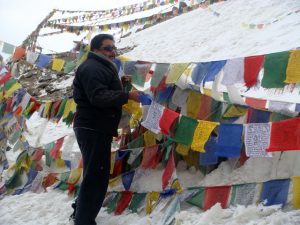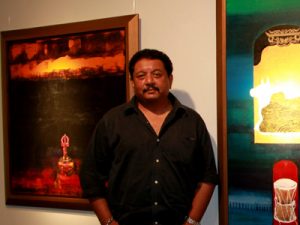There is something different about meeting an artist. It is most unlike meeting anyone else. And therein lies the twist. Here was a chance to get into the mind space of one who lives by his expression. It turned out to be an experience like no other.
On a hot, muggy afternoon, Pratap SJB Rana was there on the dot for our scheduled meeting while I struggled through the traffic chaos of the Millennium City. Pratap’s carefully casual appearance shattered myths of ethnic-clad or quirkily put together artists. Here are edited excerpts from our free-wheeling chat.
The Wonder Years
Given his armed forces upbringing, his extensive years in the corporate world and global exposure – here is a person who has broken the artist stereotype.
Hailing from an influential family from Nepal, there was nothing lacking materially and otherwise in young Pratap’s childhood. Following family tradition, Pratap was all set to join the Indian Army. He cracked the entrance examinations for the Oberoi Centre of Learning and Development and joined the business of hospitality instead. Later, his career took him to United Breweries.
The Corporate Honcho
In what was then Calcutta, Pratap was spotted and hand-picked to head the American Express business for Nepal and was based out of Kathmandu. Pratap recalls his time in Kathmandu as being extremely significant. These years enabled him to go back to his roots. He began to introspect on matters cultural and spiritual. He studied the Geeta and Ramayana and he realised that while these may be our holy books, each of them is an intricately crafted story. “The hows and the whys behind the conceptualisation of that story fascinated me.” recalls Pratap. But this side of him was carefully hidden away. “People thought I was a philistine.” laughs Pratap.
 Pratap’s corporate career saw him grow at American Express, Thomas Cook and Mastercard across multiple locations in India and the ASEAN region. Pratap recalls his varied work experience when he worked as part of teams in a silo and even by himself. He reminisces: “I loved my corporate life. I worked very hard but also experienced the best that life had to offer.”
Pratap’s corporate career saw him grow at American Express, Thomas Cook and Mastercard across multiple locations in India and the ASEAN region. Pratap recalls his varied work experience when he worked as part of teams in a silo and even by himself. He reminisces: “I loved my corporate life. I worked very hard but also experienced the best that life had to offer.”
All this while – he did not pick up a paint brush.
But deep down – he was always tuned into his surroundings – assimilating, absorbing.
One day when introspecting, something made Pratap question himself about a long forgotten talent. He wondered – “Dare I pick up the paint brush of my childhood again? Will I be able to create anything? What will happen if I do manage to create something? Can I achieve this part of my life?”
The need to create something of his own was emerging. It was only a matter of time. Pratap decided to quit his corporate life and turn to art full time. It did not exactly happen overnight. Some six odd months went in that quest. Finally and two years ago he took the plunge into the world of art.
Early inspirations were characters from epics. But Pratap would zero in on the lesser known characters who were part of the intricately woven fabric of the larger story. The ones who played a small yet significant role in taking the story forward, enabling significant learning for the protagonist. Examples of these were: Shikhandi, in the Mahabharat or Sugreev, in the Ramayan. Reminisces Pratap: “I wanted to paint. It just happened. I had no plans. Perhaps it was in my karma? All I had to do was take the first step and I began to enjoy it. Intensely so.”
His first collection was a series of 6 works titled: “Ramayana – The Lesser Heroes”.
Once the collection was completed, Pratap faced some hard questions. Was his work good enough to touch the soul? Was it something that was spontaneously likeable? What could be the yardstick to measure its success? Without wasting any time, Pratap reached out to a shortlist of art galleries to figure what his art could be worth.
Mystically, he began to receive positive responses, almost immediately.
 There was a gallery that wanted to buy his collection outright. Ironically, Pratap wasn’t even sure what to price the collection at! A leading art curator and critic was candidly said that she loved his work but also shared how Pratap could better his technique and form.
There was a gallery that wanted to buy his collection outright. Ironically, Pratap wasn’t even sure what to price the collection at! A leading art curator and critic was candidly said that she loved his work but also shared how Pratap could better his technique and form.
Over time, Pratap regularly crafted collections of art across different themes. Work began to get noticed and get picked up regularly by diplomats, business houses and individual art lovers.
Pratap has a simple take – “My work is my own. It is subjective. It’s a mirror of my soul.” So much so that he takes a keen interest in the kind of people who buy his work. He is happiest when a genuine art lover buys and showcases his work in a space where he can regularly see it. A space where he can spend time absorbing the colours, the lines, the tones. He talks about how his work is greatly influenced by Buddhism. “The calmness of Buddhism amidst the chaos intrigues me. But I do not paint the Buddha – I feel he is too large an entity. I do however, paint the characters around him. After all, if I am capturing say – a monk – I am capturing a bit of the Buddha too. It also harks back to my fascination with lesser known characters.”
Among Pratap’s other experiments is the art he created on burnt paper when travelling in Poland. Burnt paper represents the angst of the people of Poland, who had been betrayed during the World War II by the world. A great believer in Karma, Pratap feels blessed that he is able to do what he loves and loves what he is able to do. He works in an unshackled style. He follows basic form, but no real norms, since he has had no formal art school training. He prefers to work with a free mind. He likes to experiment and to paint happy stuff! Red and if’s vibrancy expresses his state of mind when he talks about what art means to him. “Art is what I feel, live and breathe. I like to have an understanding with the person acquiring my work – to ensure that my work brings him happiness. The same happiness with which it has been painted.”
On being asked what has been his biggest art achievement, his rather simple view is that, “My work should make a person happy – that’s my biggest achievement! My art is from my soul and I want it to reach out everyone.”
In this context, the partnership with WAC is something that he is looking forward to. Pratap believes that it enables the practical side of the art business as he reaches out to a larger audience. Believing that it is important for them to know him as an artist, as a person and as the guy who simply paints happy, calming, spiritual work!
